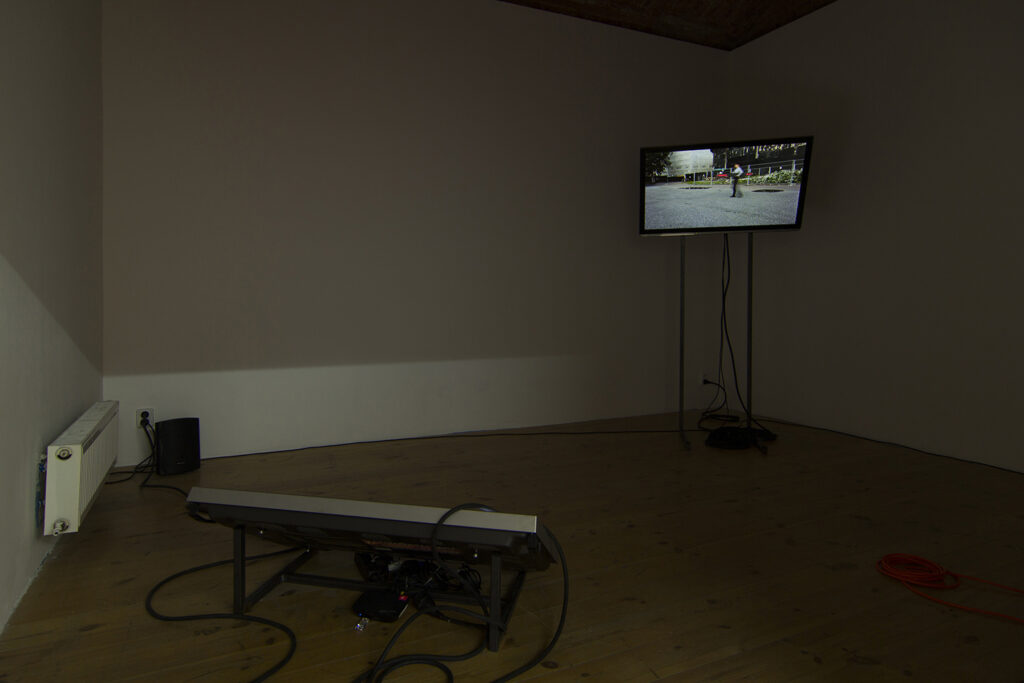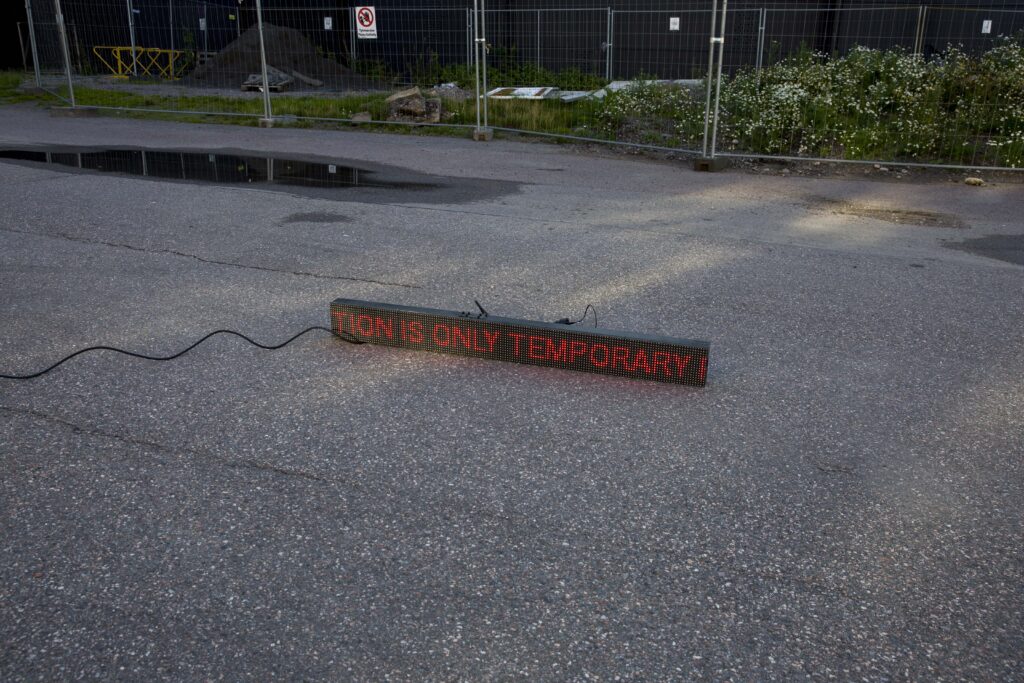25/9/2021-16/10/2021
Interview: Viktória Beličáková, Bianca Hisse, Laura Cemin
Viktória: Your project ‘What led us here’ in Gallery 35m2 focuses on the very fabric
of public spaces, its invisible mechanisms, flows and currents, which direct our bodies and their movement in space. The project is based on your research of public signs, their language and semantics which influence our behavior and the trajectories we take in our everyday life. You also address the politics of mobility and migration and how these processes manifest both in the bureaucratic setting, as well as in a more personal, intimate sense. In the exhibition you will present videos from your performances in the public space, and you will also work with LED advertising signs that we mostly see in the public space. What happens when you take all these elements, this environment, and transfer it into the gallery space?
Bianca: I’ve been working and using a lot of objects and materials from public space in my sculptures. Advertisement signs have a very specific function in public space, but when you present them in a gallery, you detach them from their original context. By putting them in the white cube where different sets of conventions and meanings are attached to it, the viewers immediately approach them differently.
Laura: Advertisements and images are obviously extremely present nowadays, so present that we almost do not pay attention to them anymore. They disappear inside the fabric of public spaces. To bring them into a gallery, where people go to actively engage with somethi
ng, is a gesture of underlining what is always present and screaming for attention, but passes unnoticed. This conceptually connects to immigration policies for instance: we are all aware of how problematic the politics around circulation and permission are, but their constant presence in the media seems to not emphasize their urgency, rather the opposite, letting the issues fade in the background, as a noise you get used to.
Bianca: The LED scrolling signs often show sentences such as “Welcome”, “We are open” in windows of shops, so we decided to use them to give visibility to things that are forgotten or overlooked by society.
Viktória: Language is one of the core elements of this exhibition. Can you explain how you work with language and with what purpose?
Bianca: In this work, the language evolves to the point of becoming poetic. We are looking for ways to twist the language; both the cold, bureaucratic one and the sexy, commercial one. How they can be twisted into something completely else – abstract, poetic – something that people might associate with their own experiences or relate to in their own context. We want to open it to more unexpected meanings.
Laura: We were very careful in choosing the specific language and the sentences used in our work, because it is very easy to fall into a judgmental narrative. With our piece we don’t want to crucify, we simply want to raise attention. When we were choosing the sentences which are scrolling on LED signs, we started working with one sentence and we quickly understood that this sentence could be read in different ways. From there, we created a poetic text using the sentences from immigration forms. This poem is not only about that, it talks about other things as well – relationships in general, intimacy, belonging. We are trying to open this concept and give space to the audience to put their own experiences into the work. It’s more a proposal for the audience. That’s what I expect from the work. It is a statement, but…
Bianca: …it’s not a conclusive answer.
Laura: Exactly.
Viktória: You work with two opposing modes of language – the language of advertising and bureaucracy – which we encounter in quite different situations and circumstances. You chose them intentionally, but their parallels and connections are not obvious right away. Why did you decide to juxtapose these two forms of language in particular?
Bianca: The language of advertisement is attractive, while the language of immigration policies is bureaucratic, but they have something in common. They are both essential in neoliberal economies and they are part of the strategies that this type of economy needs to either allow or forbid movement in the public space. They are also both linked to political decisions.
Laura: I agree. We started by thinking how these signs are used and what kind of sentences are usually shown. We understood very quickly that they are mostly about entering and exiting, bringing someone in and letting someone out. When you apply for a visa to enter a country, you often must prove that you have enough money to bring to the country. So, if you have money, you are welcomed, in a sense. Economy and money are still at the center of it.
Viktória: The poetic narrative shown on the LED signs is only one part of your work. The second part features two individual filmed performances in public space. Can you tell me more about the places that you chose for your performances? What led you to that choice?
Bianca: First, we agreed on making a performance using advertisement signs to see what those could generate in public space. We wanted parallel actions, happening both in Norway and Finland, to have the performance connect our own contexts and create a comparison and relation between these two countries where we have been mostly based, where we have been going through many bureaucratic processes just to be able to live here. It was very important for us to refer to our own social situation. We both chose similar locations: empty spaces, parking lots with fences around. For me, these are in-between spaces without much life, connecting to the transitory state of being a foreigner, or being always in-between countries.
Laura: In Helsinki, I chose a very big open space in the middle of the city with a huge metal construction that is now not in use, and it resembles a parking lot. There are many things going on there – fences, different buildings, a lot of graffiti. It was interesting for us to have these signs that ask for attention in a kind of deserted urban landscape and to make people ask the question why it is here. The whole exhibition is called ‘What led us here’ and we want to raise the question in our videos – what led us as performers here, to these places, why did we choose them? But also, why as immigrants did we move to Scandinavia? What led us here?
Viktória: Your performance is mostly based on movement, and it seems like you are following or executing certain choreography. How do you understand the concepts of movement and choreography and how do you link them together?
Laura: The word choreography was at the beginning used mainly in dance context; it means to write movements. Everything is choreographed, and public spaces are highly choreographed too. Traffic lights, pedestrian paths and other elements direct our movements, force us to stop, turn around, keep a distance. Choreography is just putting movements into a sequence and these movements could be any movement, could be bodily movements, or could be all the ste
ps necessary to get from one point to the another, either physically or mentally. With Bianca we were thinking a lot about choreography of bureaucracy as well, since Bianca and I have been performing this “paper” choreography for a while now as immigrants: getting a paper from one office, bringing it to another one, and being sent back to the first one because of a missing signature,… it can go on forever!
Bianca: I think we could talk about choreography as a system, while movement is a direct action within a system. Public spaces have their own system, which suggests specific ways of moving, with patterns and styles.
Laura: If choreography is the system, movement is how we navigate it.
Bianca: For me, the power or potential of working with movement, body and choreography is that the context highly informs what a movement will generate in the space.
Laura: In more general terms, movements don’t have meaning without context. When I
raise my hands in a religious context, it means something, but if I do the same movement during a concert, it will mean something else. Very simple motions in two different contexts mean two different things. We have been very interested in meanings that are projected on movements, what these meanings are and how we relate to them.
Viktória: When you perform in the public space, you are moving through the underlying currents of that space in order to visualize, materialize, and embody certain experiences. How do you work with your body in that context?
Laura: Our bodies are influenced by our environment and everything that is around us, therefore society obviously influences them too. Everything we are surrounded by, everything we hear and see must be digested. Our body is an archive of all these histories, rules that we often don’t realize we carry. At least for me, it was very interesting to see the resonance of societal structures in my body and how my body reacts to them. I was working more intuitively exploring how the words we chose for the LED sign influence my body, how do I move and how do I carry all this baggage. We have been looking at different ways of entering, snuggling into different places, and exiting. crawling, sliding, rolling, climbing. But also about our relation to the sign and the words. What is our relationship to all this language? In the choreography
I perform, I actively carry the sign with my body and I see it as a metaphorical way of asking what do you carry, what is your baggage?
Bianca: For me, performance and the body have the potential to highlight things that people are not paying attention to. This is often my point of departure: to learn how to be sensitive to my surroundings, and allow meanings to emerge through the situation that I create.







